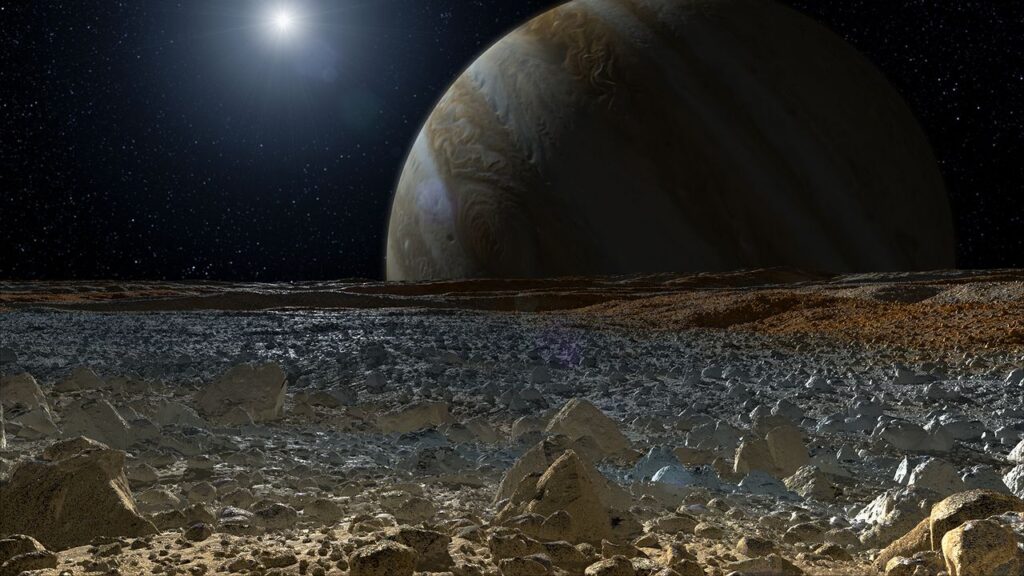
New findings from the James Webb Space Telescope (JWST) have transformed our understanding of Europa, one of Jupiter’s moons, revealing that its icy crust is not as static as previously believed. The latest observations indicate a dynamic environment beneath the moon’s frozen surface, which could have significant implications for its potential habitability.
For many years, scientists envisioned Europa’s surface as a still and lifeless shell. However, the recent data underscores that this moon is an active world, teeming with geological processes. Richard Cartwright, a spectroscopist at Johns Hopkins University and the lead author of the study, stated, “We think that the surface is fairly porous and warm enough in some areas to allow the ice to recrystallize rapidly.” This revelation marks a significant shift in the perception of Europa’s geophysical characteristics.
New Insights into Subsurface Activity
The study, published on May 28, 2023, in The Planetary Science Journal, specifically examined two regions in Europa’s southern hemisphere: Tara Regio and Powys Regio. Among these, Tara Regio emerged as particularly fascinating. JWST’s observations detected crystalline ice on both the surface and beneath it, challenging earlier assumptions regarding the distribution of ice on Europa.
The research highlights the presence of “chaos terrains,” which are highly disrupted areas where blocks of ice appear to have broken off, drifted, and refrozen. Such terrains provide unique insights into the moon’s interior and its subsurface ocean. Ujjwal Raut, a program manager at the Southwest Research Institute and co-author of the study, noted, “Our data showed strong indications that what we are seeing must be sourced from the interior, perhaps from a subsurface ocean nearly 20 miles (30 kilometers) beneath Europa’s thick icy shell.”
In addition to geological activity, the study examined how the radiation environment on Europa affects its ice. Raut and his colleagues conducted laboratory experiments simulating conditions on the moon, revealing that the intense radiation disrupts the typical hexagonal structure of ice, resulting in amorphous ice—an unordered, noncrystalline form. This transformation provides crucial insights into the moon’s surface dynamics.
Compelling Evidence of Chemical Activity
The findings also reveal intriguing chemical signatures that suggest the presence of a subsurface ocean. Cartwright emphasized, “In this same region […] we see a lot of other unusual things, including the best evidence for sodium chloride, like table salt, probably originating from its interior ocean.” Additionally, the presence of carbon dioxide and hydrogen peroxide in these regions is indicative of ongoing geological processes.
JWST’s NIRSpec instrument was instrumental in this analysis, as it can detect critical chemical signatures across a broad range of infrared wavelengths. This capability allows scientists to identify features associated with crystalline water ice and specific forms of carbon dioxide, such as 13CO2. The high sensitivity of NIRSpec enables the creation of detailed maps that illustrate the distribution of materials across Europa’s surface.
The researchers observed elevated levels of carbon dioxide in the chaotic regions, concluding that it likely originates from the subsurface ocean rather than from external sources like meteorites, which would lead to a more uniform distribution. The instability of carbon dioxide under Europa’s intense radiation further suggests that these deposits are relatively recent and reflect active geological processes.
As the research progresses, scientists are left with compelling questions about the origins of carbon-13 and its implications for understanding Europa’s internal chemistry. Cartwright remarked, “Where is this 13CO2 coming from? It’s hard to explain, but every road leads back to an internal origin, which is in line with other hypotheses about the origin of 12CO2 detected in Tara Regio.”
This groundbreaking study arrives at a pivotal moment as NASA’s Europa Clipper mission is en route to the Jovian moon, with an expected arrival date in April 2030. The spacecraft will conduct numerous flybys, each aimed at gathering critical data about the ocean hidden beneath Europa’s icy crust. This ongoing exploration promises to deepen our understanding of one of the solar system’s most intriguing worlds.







